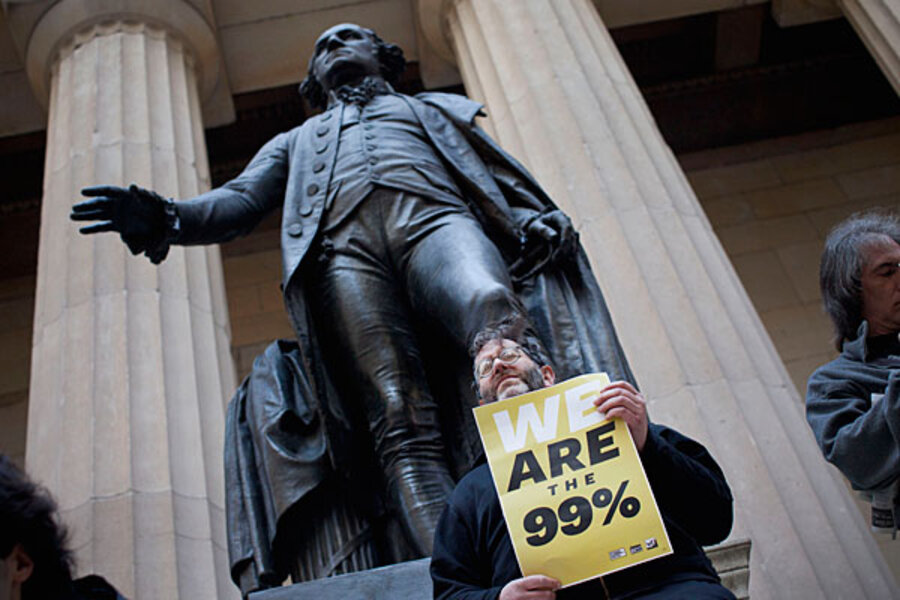How Occupy Wall Street plans to spring back to action
Loading...
| Los Angeles
After a relatively low-profile winter, the movement that branded pup-tent activism into the national consciousness is embracing the advent of spring.
In Washington Friday the Occupy Wall Street (OWS) movement is launching its second act, kicking off a month-long series of marches, training sessions, and general assemblies with Occupyers from all over the nation.
Dubbed National Occupy Washington (NOW), the event began with a march on the Environmental Protection Agency – accompanied by a brace of alpacas, a large polar bear, and a even larger blow-up of planet Earth.
“This is just the tip of the iceberg,” Kevin Zeese, one of the coorganizers, says by cell phone while marching under the overcast capital skies.
“We are preparing to give people the skills and training they need for longer and more powerful involvement,” he says, adding, “the tents were just a tactic, not the purpose of this movement.”
While many have seen the disappearance of the signature tents from downtown parks from New York to Oakland and Boston to Los Angeles as a sign that OWS had lost both its appeal and vigor, Mr. Zeese counters that long-term social campaigns such as the civil rights movement unfolded over years and took many forms as they progressed.
“We may be less visible, but we are just getting started,” Zeese says.
Spring is inspiring other OWS-related activism as well, including the 99 Percent Spring, a coalition of progressive groups launching large-scale nonviolence training for its members and a national call for a general strike on May 1.
OWS is in transition, says Mark Tatge, journalism professor at DePauw University in Indiana. “I don't see it dying, I see it morphing into something beyond just an attack on the big banks or Wall Street,” he says via e-mail, adding that the seeds of this movement can be seen elsewhere.
“There is really more than one ‘Occupy Wall Street’ movement underway,” says Professor Tatge, pointing to coalitions of groups mobilizing over issues such as immigration, fights over creationism in schools, a fierce battle over health care now before the Supreme Court, and the recent shooting of an unarmed teen in Florida.
“I expect more, not less, political activism over the next five years,” he says. “Most of this is because of the widening split between the haves and have-nots in this country.”
The decision to train Occupy members in nonviolent direct action methods demonstrates the movement’s decision to help set the political agenda, says Villanova University political scientist Catherine Wilson, adding that it shows that OWS is attempting to expand its base of core supporters and sustain movement participation.
“A central way of sustaining movement participation is through engagement in coalition advocacy with a range of Occupy allies,” she says via e-mail. “Both secular and faith-based.”
Ms. Wilson points to other upcoming events on the OWS “Spring Training” calendar, such as on April 1, Occupy Philadelphia is hosting Occupy Holy Week/Passover.
The intention of Occupy Holy Week/Passover, she says, is “to showcase how the movement resists injustice through the use of nonviolent methods.”
The day will begin with a march to the sites of “modern-day Pharaohs” and will end with the sharing of a Seder meal. Through the use of religious symbolism, Wilson says, Occupy is purposely evoking the history of other nonviolent social movements led by such historical figures as Mohandas Gandhi, Martin Luther King Jr. and César Chavez.
However not everyone is so persuaded about the long-term outlook for OWS.
“The movement has lost most of its relevance,” says Republican strategist David Johnson, who worked on Bob Dole’s 1988 presidential bid.
The high-profile events such as police clashes with demonstrators everywhere from the University of California at Davis to New York’s Zuccotti Park kept the concept alive in the minds of many Americans, he says. But now, with news of unemployment going down and new job-creation rising, he says, “this movement is going to have to struggle to be relevant any more.”





